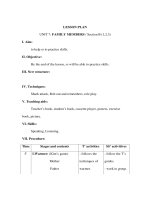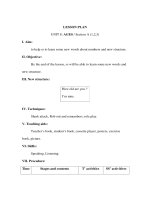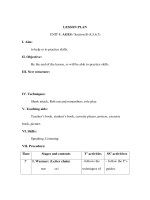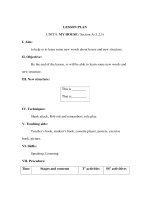- Trang chủ >>
- Mầm non - Tiểu học >>
- Lớp 2
Global Success_Grade 2_Lesson plan Unit 14_Giáo án Unit 14
Bạn đang xem bản rút gọn của tài liệu. Xem và tải ngay bản đầy đủ của tài liệu tại đây (111.41 KB, 15 trang )
TIẾNG ANH 2
LESSON PLAN
School:
Grade:
Teacher:
____________________
____________________
____________________
School year:
Week:
Approved by:
____________________
____________________
____________________
Unit 14. At home
Lesson 1 – Period 1
Date: _______________
I. OBJECTIVES
II. INPUT
By the end of the lesson, pupils will be able to:
- pronounce the sound of the letter combination er (/ə(r)/)
in isolation;
- say the word brother, sister and grandmother
Language:
- Sound (/ə(r)/)
- Vocabulary: brother, sister and grandmother
Resources/Material:
- Student’s book, p. 60
- Teacher’s guide, pp. 118-123
- Website hoclieu.vn
- Flashcards/ pictures of family members
- Poster (Unit 14: At home)
- Computer, projector
1
III. PROCEDURE
Procedure
Warm-up
Warm-up – Listen and repeat. – Point and say.
– Fun corner – Wrap-up
Teaching and learning activities
Classroom
management
5 minutes
Option 1: Singing the song in Unit 13, Lesson 3.
- Ask pupils to sing the song in Unit 13, Lesson 3
and point to the numbers (flashcards 11-15)
when
singing.
- Have some pupils demonstrate the song in front
of the class, the rest of the class listen to them
and clap hands.
Option
2:
Drawing.
- Show pupils some pictures/ slides of popular
toys/ animals or fruit with the quantity from 1115.
- Have pupils count them, then write the number
on the board and say it out loud.
Option
3:
Game:
Number
race.
- Draw on the board numbers from 1 - 15 (each
number
on
a
square).
- Divide the class into 4 groups. A pupil from each
group comes, throws a dice and move. Continue
playing one by one, then who gets the number 15
first will be the winner.
Whole class
Individual
work
Whole class
Group work
1. Listen and repeat. 10 minutes
Have pupils look at the picture, saying Look at the
picture, please! and describe it. Draw pupils’
attention to “er” (/ə(r)/). The picture shows a
Step 1:
family at home. Brother, sister and grandmother,
with the letter combination “er” in red.
Check comprehension.
2
Whole class
Have pupils point to the letter combination er (say
Individual
Step 2: “Point to the letter combination er.”) and listen to
work
its sound (say “Listen. /ə(r)/.”).
Play the recording of the sound of the letter
combination er and encourage pupils to repeat
(say “Listen and repeat.”). Do this several times,
with pupils repeating both individually and in
Step 3:
Whole class
chorus. Correct their pronunciation if necessary,
and praise them when their pronunciation is good.
Play the recording. Have the pupils listen and
repeat.
Have pupils look at the brother (say “Look at the
brother.”) and point to the word brother (say
Individual
Step 4: “Point to the word brother.”). “Look at the colour
work
of the letter combination er. It is red.” Do the same
with the other words.
Play the recording again and have them listen,
point to the letters “er” and the words then repeat Individual
Step 5:
until they feel confident. Give further support to work
those pupils who find it difficult to do the task.
Play the recording in full and encourage pupils to
repeat the sound of the letter combination er, Whole class
Step 6: brother, sister and grandmother both individually
and in chorus. Saying Well done! when they
perform well.
Extension:
For higher level of pupils, using pictures/slides of
family members in, have the pupils make labels for
Individual
them (mom, dad, brother, sister, grandma,
work
grandpa…). Ask them to match the words to the
pictures and practise saying the words.
2. Point and say. 7 minutes
Step 1: Have pupils look at the picture again (say “Look Whole class
at the picture on Page 60, please!”). Ask them to
describe it. Draw their attention to the “er”, and
the family members.
3
Step 2: Get them to point to the “er” and say it (say
“Point to the “er” and say, please!”.
Step 3: Ask pupils to point to the family members and
say the words. Give further support to those
Step 4: pupils who find it difficult to do the task.
Ask pupils to work in pairs or in groups to point
to the picture in their books and say. Go around,
offer help and correct pronunciation, if
necessary.
Step 5:
Invite some pupils to point to the picture and
say the sound of the letter and the words in
front of the class. If they perform well, praise
them, saying Well done! or Very good!
Whole class
Individual
work
Group/Pair
work
Individual
work
Extension: - For lower level of pupils, have them do Activity Whole class/
1,3, page 43 in their workbooks.
Individual
- For at or higher level of pupils, have them do work
Activity 1-3, page 43 in their workbooks.
Fun corner:
Game: What is it? 8 minutes
Step 1: Tell pupils how the game is played. Have all
pupils stand at one end of the classroom.
Step 2: Hold a flashcard for the pupils to come forward
and whisper the word to you. If word is correct,
the pupil stands on the other side. If not, he/she
must go back and wait for another turn.
Step 3: When all pupils are standing on the other side of
the classroom, have them shout out the word.
Play the game.
Step 4: Continue to play the game until the last word.
Wrap-up
Whole class
Individual
work
Whole class
Whole class
5 minutes
Revise the main teaching point of the lesson: the Whole class
sound and the words.
4
Option 1:
Using hoclieu.vn, have pupils look at the words
in the picture and repeat after the recording.
Option 2:
Using poster of the unit, ask pupils to point to
the words and say out. For better pupils, teacher
may cover the words and ask them to point to
the things and say the words aloud.
Option 3: Matching game
Using pictures and flashcards, get 3 pupils hold
the pictures and 3 more hold the words. Ask
them to find and match the picture with the
word correctly. Praise the ones who finish the
matching. Then ask the class to look and say the
words aloud.
5
Whole class
Individual
work
Individual
work/ Whole
class
TIẾNG ANH 2
LESSON PLAN
School:
Grade:
Teacher:
____________________
____________________
____________________
School year:
Week:
Approved by:
____________________
____________________
____________________
Unit 14. At home
Lesson 2 – Period 2
Date: _______________
I. OBJECTIVES
II. INPUT
By the end of the lesson, pupils will be able to:
- pronounce the sound of the letter combination er (/ə(r)/)
correctly, the words sister, brother, grandmother;
- say combination “er”, the words sister, brother,
grandmother;
- say the sentence structure He’s/She’s _____ (age) (16-19)
in a chant;
- listen and identify the words sister, brother, grandmother.
- write the combination “er” and complete the words
grandmoth__ __, broth__ __, sist__ __.
Language:
- Sound combination “er” (/ə(r)/)
- Vocabulary: sister, brother, grandmother.
- Sentences with the sound “er” and the words sister,
brother, grandmother.
Resources/Material:
- Student’s book, p. 61
- hoclieu.vn
- Teacher’s guide, pp. 120-121
- Workbook, p. 44
- Computer, projector
6
III. PROCEDURE
Procedure
Warm-up
Warm-up – Listen and chant. – Listen and circle. –
Write and say. – Wrap up
Teaching and learning activities
Classroom
management
5 minutes
Option 1:
Ask two or three pupils to look at the picture in
Lesson 1 (Student’s book or hoclieu.vn) and say
the sound of the letter “er” and the family
words.
Option 2:
Have pupils play Chinese whisper game, using
the words learnt in the previous lesson (Set a
competition of 2 or 4 groups).
Option 3:
Get each pupil to draw their family (or bring a
photo of his/her family), then talk about the
pictures/photo to their classmates.
Whole class
Group work
Individual
work
3. Listen and chant. 10 minutes
Step 1:
Step 2:
Step 3:
Have pupils look at the chant. Say “Look at the
chant, please!” Draw pupils’ attention to the
first verse and explain its meaning by looking
at the picture. Ask them to pay attention to
the combination “er” and the words sister,
brother,
sixteen,
nineteen.
Check
comprehension.
Play the recording of the first verse for pupils
to listen and to get familiarized with the tune,
saying “Listen to the first verse, please!”. Then
play the recording again for them to listen and
repeat until they feel confident, saying “Now
listen and repeat, please!”.
Follow the same procedure with the second
verse. Correct pronunciation, if necessary.
7
Whole class
Whole class
Whole class
Step 4:
Step 5:
Extension:
Give further support to those pupils who find
it difficult to do the task.
Play the recording all the way through. Ask
pupils to listen and repeat the chant
individually and in chorus, saying “Listen and
chant, please!” Go around and offer help, if
necessary.
Select some pupils to the front of the class to
chant and clap their hands. The rest of the
class may sing the chant along and clap their
hands. If they sing the chant well, praise them,
saying “Good job!” or “Very good!”.
1. Ask pupils to look at the picture in Activity 3,
work in pairs and take turns chanting
together.
2. For better pupils, cover some letters/words
in the chant and have them guess and say all
the lines aloud. For example:
Er, er, sister.
She’s my ________.
She’s ________.
Er, er, brother.
He’s my ________.
He’s ________.
4. Listen and circle.
7 minutes
8
Group work/
Individual
work
Individual
work
Pair work/
Individual
work
Step 1: Have pupils look at the pictures of Question 1
and say (say “Look at the pictures and say,
please!”). Draw pupils’ attention to the pictures
above the letters a and b. Check
comprehension.
Step 2: Invite some pupils to point to the pictures and
say the words in front of the class (say “Point to
the pictures and say, please!”). Eg.: 1a: sixteen
1b: seventeen.
Step 3: Play the recording of the first sentence for
pupils to listen and circle the correct letter (a or
b). Say “Now listen and circle, please!”. Play the
recording of the first sentence, several times if
necessary, for pupils and check uderstanding.
Ask “What did you hear?, We circle a, or b?”.
If they answer correctly, praise them Very good!
or “Well done!”
Step 4: Follow the same procedure with the pictures in
Question 2. Give further support to those pupils
who find it difficult to do the task.
Step 5: Call a few pupils to the front of the class to point
to the pictures and say what they have heard.
Check answer:
Audio script: 1. My brother is seventeen.
2. My sister is twenty.
Answers: 1. b 2. b
Whole class
Individual
work
Individual
work
Whole class
Pair work/
Whole class
5. Write and say. 8 minutes
Step 1:
Have pupils look at the letters “er” (say “Look at Whole class
this. What can you see? Yes, you can see the
letters “er”. We say /(/ə(r)/).”). Check
comprehension.
9
Step 2:
Write the combination “er” on the board, saying Whole class
“Look at the board. What can you see now? Yes,
you can see the letters “er” - we say /(/ə(r)/)”.
Check to make sure pupils understand the
written letters.
Step 3:
Tell pupils to write the letters “er” (say “Now, Individual
let’s write!”) You can demonstrate writing in the work
air. Then let pupils do the writing. Go around
and offer help, if necessary.
Step 4:
Check the results of pupils’ writing and give Pair work
feedback. Ask pupils to work in pairs and swap
their answers (say “Now work in pairs and check
each other’s answer”). Give pupils time to work.
Go around and offer help, if necessary.
Extension:
- For lower level of pupils, have them do Activity Individual
4,5, page 44 in their workbooks.
work
- For higher level of pupils, have them do
Activity 4,5, page 44 in their workbooks, then
say it oud loud.
Wrap-up:
5 minutes
Option 1: Have pupils listen to the recording,
then say the chant again.
Option 2: Ask pupils to look at the pictures in
Activity 4: Listen and circle, then talk about the
pictures. Encourage higher level of pupils to use
learnt structures e.g. He’s sixteen, He’s
seventeen/She’s nineteen, She’s twenty.
Option 3: Game: Pass the ball.
Ask pupils to pass the ball with the music. When
the music stops, the one keeps the ball has to
say the numbers from 16-20 writen randomly on
the board.
10
Whole class
Whole class
Individual
work
TIẾNG ANH 2
LESSON PLAN
School:
Grade:
Teacher:
____________________
____________________
____________________
School year:
Week:
Approved by:
____________________
____________________
____________________
Unit 14. At home
Lesson 3 – Period 3
Date: _______________
I. OBJECTIVES
By the end of the lesson, pupils will be able to:
- use the sentence structures How old is your _____? and
He’s/She’s _____ (age).;
- to ask and answer questions about someone’s age;
- sing a song with the sentence structures How old is _____?
and He’s _____ (age).
II. INPUT
Language:
- How old is your _____? and He’s/She’s _____ (age).
Resources/Material:
- Student’s book, p. 62
- hoclieu.vn
- Teacher’s guide, pp. 122-124
- Workbook, p. 45
- Computer, projector
11
III. PROCEDURE
Procedure
Warm-up
Warm-up – Listen and repeat – Let’s talk – Let’s sing –
Wrap up
Teaching and learning activities
Classroom
management
5 minutes
Option 1:
- Have pupils listen to the recording, then sing/
read the chant in Lesson 2.
- Select some pupils to chant in front of class.
The class listens to them and claps hands
along.
Option 2:
- Show pictures/ slides of family members/
numbers from 16-20 quickly and let the pupils
guess/ say it out loud.
- Ask them to recall, then encourage higher level
of pupils to say more words/ phrases if they
can.
Option 3:
Invite one or two pupils to write the
combination “er” and some words with these
letters on the board. Make it become a
competition between groups to be more
interesting.
Whole class
Whole class/
Individual
work
Group work
6. Listen and repeat. 5 minutes
Step 1: Have pupils look at the picture, point to the boys Whole class
and the brother, then say “Who is it? (brother),
How old is he? We ask: How old is your brother?
(point to the sentence)”, saying “Look at the
sentence, please!” Explain the meaning of the
sentence and how it is used. Check
comprehension.
Step 2: Play the recording several times for pupils to Whole class
listen and repeat the sentences, saying “Now
12
listen
and
repeat,
please!”
Play
the
recording
and
invite
some
students to
Step 3:
repeat the sentences “How old is your brother?”,
“He’s nineteen.”. Correct pronunciation to make
sure pupils can repeat correctly the sentence.
Give further support to those pupils who find it
Step 4: difficult to do the task.
Invite some pupils to say the sentences in front
of the class.
7. Let’s talk.
Individual
work
Individual
work
10 minutes
Step 1: Have pupils look at the bubble to understand Whole class
and practice structure “How old is _________?”
to ask someone’s age). Explain the meaning of
the sentence, if necessary.
Step 2: Have pupils look at the first picture. Point and
say Look at this picture, please! Point to the cake Whole class
and ask them “What is this?”. The pupils answer
“a cake”. It’s this boy’s birthday. He’s a brother.
How old is he? Tell them to ask in a whole
sentence “How old is your brother?” then
answer “He’s sixteen.”.
Step 3: Point to Picture a and model, using the
expression in the bubble and the picture. Write
How old is your brother? and He’s _____. on the
board.
Ask pupils to point to Picture a (say “Point to
Step 4:
Picture a and say.”) and ask “How old is your
brother?” then answer “He’s sixteen.”. Correct
pronunciation, if necessary.
Follow the same procedure with other pictures.
Step 5: Give further support to those pupils who find it
difficult
to
do
the
task.
Select some pairs of pupils to practise asking
Step 6: and answering in front of the class. Praise them,
13
Whole class
Whole class
Whole class
Pair work
Extension:
saying “Excellent!” if they perform well.
Group work
Play Memory game. Divide the class in four
groups. Show pictures of brothers/sisters with
birthday cakes quickly. Students from 4 groups
will raise their hands to answer the questions:
“How old is your sister/ brother?” in their
memory. Give points to the winner.
8. Let’s sing. 10 minutes
Step 1: Have pupils read the lyrics to get familiarized Whole class
themselves with the first verse of the song. Say
“Now look at the first verse, please!” Check
comprehension.
Step 2:
Play the recording several times for pupils to Whole class
repeat line after line to make sure that they can
sing the first verse correctly. Say “Listen and
repeat, please!”.
Step 3:
Follow the same procedure with the second verse Whole class
of the lyrics. Praise them when they perform well,
saying “Excellent!”.
Step 4: Have pupils listen to the whole song and sing Whole class
along. Draw their attention to the pronunciation,
the stress and the melody of the song (say “Now
listen to the whole song and sing, please!“).
Let pupils practise singing the song.
Step 5:
If there is more time, let them sing the song Individual
several times or ask some pupils to sing the song work
individually.
Extension:
1. Practise two-part singing. Divide the class into Group work
two groups and ask each group to sing one part
of the song.
2. - For lower level of pupils, have them do
Activity 6,7, page 45 in their workbooks.
- For at or higher level of pupils, have them do
Activity 6,7, page 45 in their workbooks then
14
practice speaking with their friends.
Wrap-up
5 minutes
- Revise the main teaching point of the lesson:
the structure How old is _____? and He’s _____
(age).
Option 1: Ask pupils to draw/ show pictures of
their family members and talk about them, using
How old is _____? and He’s _____ (age).
Option 2: Have pupils draw a phonics flowers
with “er”. For example:
Whole class
Individual
work
Group work/
Individual
work
Stick the flowers on the classroom wall and let
pupils go around to see and see others.
Option 3: Show pupils the lyrics of the song with Whole class/
some missing words, e.g.:
Individual
That’s my ________.
work
How old is he? He’s ________.
My ___________ is here.
My ________ is here.
We are all here.
At his ________ party.
Then ask some advanced pupils to guess the
missing words and sing the complete song
aloud.
15









